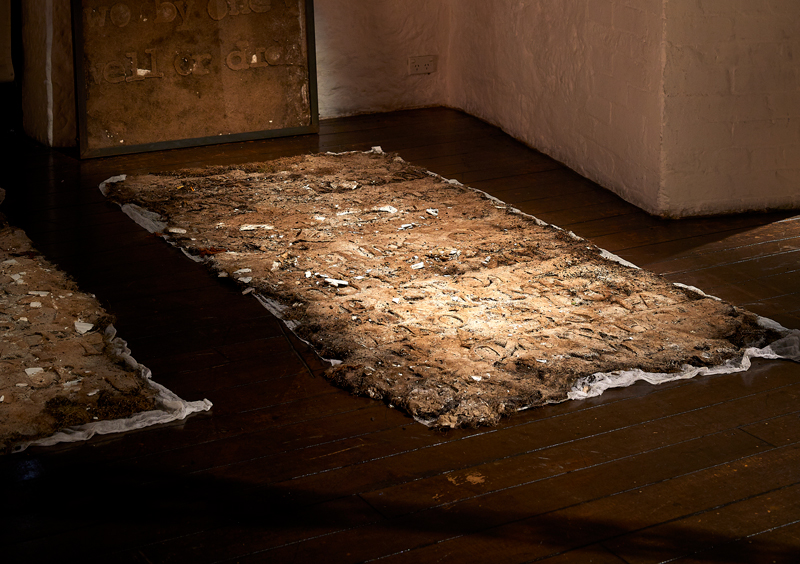
In 1961 Science Fiction writer Robert Heinlein published Stranger in a Strange Land, the story of a human survivor of an expedition to the Red Planet, who comes to Earth in early adulthood after being born on Mars and raised by Martians. The title is often cited as a stand-in for the dislocation of identity and belonging for people placed in new and unfamiliar situations. In Older Than Language, the Salamanca Arts Centre’s major exhibition for 2020, first-generation migrants might well be conceived as strangers in a strange land, while second- and later-generations of migrants are by extension strangers in a familiar land.
In 1963, two years after the publication of Heinlein’s book, nine-year old English girl, Elizabeth Day, along with her parents and younger sister Sarah, stepped off a ship and first set foot on Australian soil, having left their home outside of Liverpool forever. She states that (upon arrival in Australia) “I had a sense of unreality and dreamed I was in a movie, one in which I played the role of the stranger. As many writers have described, a stranger can make no assumptions, and they must continually reinvent themselves. And that edge, that edginess, that necessity, becomes one’s life, one where there is no turning back. This role of the stranger defines for me the migrant, living in the in between what one has left and where one is, between past and present.”[1]
Being British in the last years of the White Australia Policy did not ensure a soft landing or ready acceptance, particularly for a child. Nor did being migrants by choice rather than necessity lessen the intensity and resonance of the wrench of leaving home, family, friends – all that is familiar and comfortable – particularly for the comprehension of a child.
It is of course an entirely different case to leave one’s home under duress and persecution, as is the case for those artists in this exhibition who were displaced persons and refugees. Curated by Nina Miall and Jiva Parthipan (who developed the excellent workshop and community engagement series, which sadly could not be realised due to the Covid-19 Lockdown), the stated curatorial premise of Older Than Language is that it focuses on “the particular situation of the contemporary migrant experience within Australia – issues of cultural displacement, the fragmentation of diasporic identity, the instability of memory, the pain of exile and impediments to belonging.”[2]
Upon entering the darkened space of the Salamanca Art Centre’s Long Gallery, the exhibition feels expansive. Separated by pools of subdued lighting each work is situated within its own space; the movement from one to another, an occasion of serial procession, is like the journey through life itself. What makes this exhibition compelling is that the artwork is not burdened by an overtly didactic approach to identity politics or the historical conditions, complex as they are, that have governed settlement and migration to Australia. Older Than Language gives voice to more personal positions, based on stories and lived experience underscoring an individual’s place in the world. Somewhere between the place of origin and the new “home” is where the essence of the migrant identity lies, forever floating between these two poles.
The first work encountered is Jenna Lee’s Their Words, a group of containers fashioned after the traditional Indigenous Dilly Bags and Coolamons. Here, they sit quietly on a shelf, quite beautiful and unassertive, belying the fact that the paper pulped from a second-hand children’s book from 1955 perpetuated racial prejudice. An act of personal dominance over the text, these uncredited harmful narratives, effectively removed from circulation, strike deeply into the heart of cultural appropriation and colonial arrogance, underscoring Lee’s hybrid identity as Queer, Asian and Aboriginal.
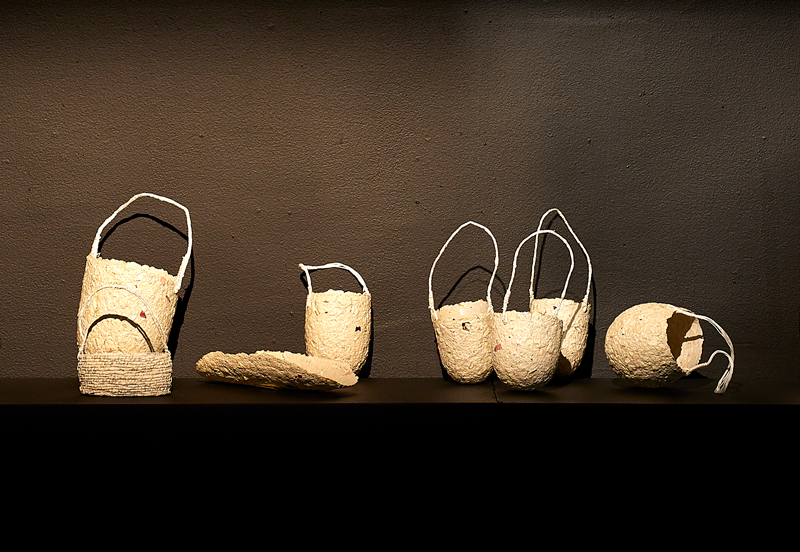
There are many layers to the diasporic experience, and intergenerational reflection on the cultural source as it becomes less a fact of direct experience, relegated to the historical record as a form of nostalgia that we might perceive as kitsch. These are the central concerns of Eugenia Lim’s work New Australians (Yellow Peril) and New Australians (Welcome Stranger), the titles of both alluding to the impetus of the gold rush on the Australian–Chinese identity. Yellow Peril deploys humour to good effect. Here, the gold-suited Chinese “Ambassador” visits Sovereign Hill, a prime example of pop-cultural kitsch as a re-enactment of a gold-mining town of the 1850s – a time when the major influx of Chinese people seeking fortune on the Australian goldfields occurred.
This xenophobic “othering” embedded in the term “Yellow Peril” has itself been handed down as a familiar term in the Australian vernacular. Inspired in part by the Jacques Tati film Playtime (1967), the figure of the Ambassador in Lim’s video traverses the main street and buildings of Sovereign Hill as a detached and bemused alien observer, caught up in but somehow separated from the throngs of tourists (no doubt, many of them Chinese) out of place and out of time, like the period-costume-clad locals crowding the scene.
In this performance the reality of the Ambassador’s presence is just another staged incursion into an existing ahistorical unreality, begging the question: “What is real?”. This is a complex world of shifting signifiers and interwoven partial narratives which underlie the conflicted post-colonial narrative of settler cultures. Our history it loaded. This is further demonstrated in the two elements of the second component of Lim’s installation that depict on one panel Chinese family figures and on the other an image of the Ambassador figure taken at Sovereign Hill as a staged nineteenth-century studio portrait printed on the shiny gold surface of rescue blankets.
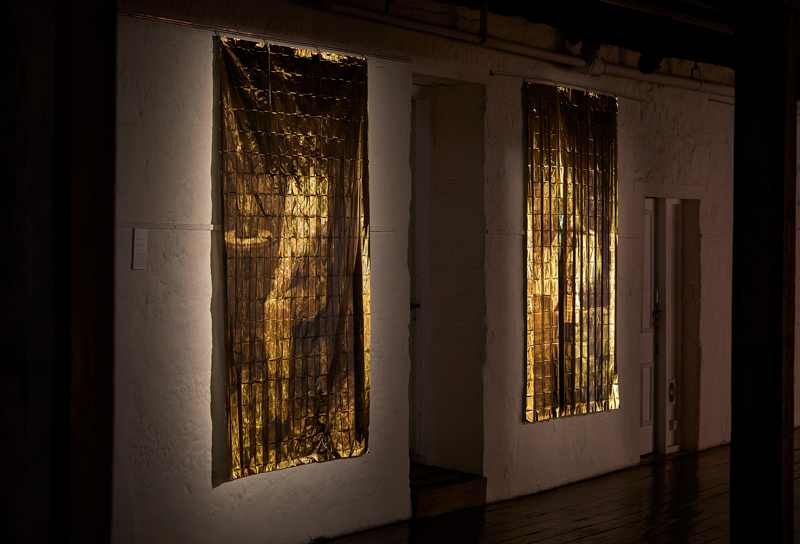
Returning to the experience of Elizabeth Day. Her work Liverpool/Liverpool is a component of a series of works which Day has been developing from 2000. The work developed as large casts of Indigenous grass-and-root structures embedded within the soil and shaped to spell out significant words and phrases derived in this case from the poem Émigré by her poet sister Sarah. These root mats are then removed and presented in their raw final state. Day has often used plants, gardens and the concepts of planting and growth in her work, stating that, “My practice is based on a theory of art that is integrally related to earth … in itself a form of migration, or transplantation.” As Peter Hutchings comments, “Her work cultivates an alternative ecology founded on the ethics of care and generosity … and attempts to make amends for injuries both personal and historical.” The work also echoes the significance of establishing place, working the land and cultivating plants as central to establishing one’s roots, pointing out that the notions of Place and Home are virtually indivisible.[3]
Across this exhibition, the place of language in the formation of cultural identity is of vital significance. It is a given that we are formed in language and that each language contains unique aspects of the values, behaviour, psychology and philosophy of specific ethnic, racial and cultural groups. This is most strongly expressed by the writers featured in Zanny Beggs’ Stories of Kannagi. For one of them, becoming proficient in Tamil is essential to her need to explore and strengthen her identity as Tamil. It is important to note that many Tamils have grown up speaking Singhalese as Tamil was discouraged but not entirely suppressed by the 1956 Official Languages Act of Sri Lanka.
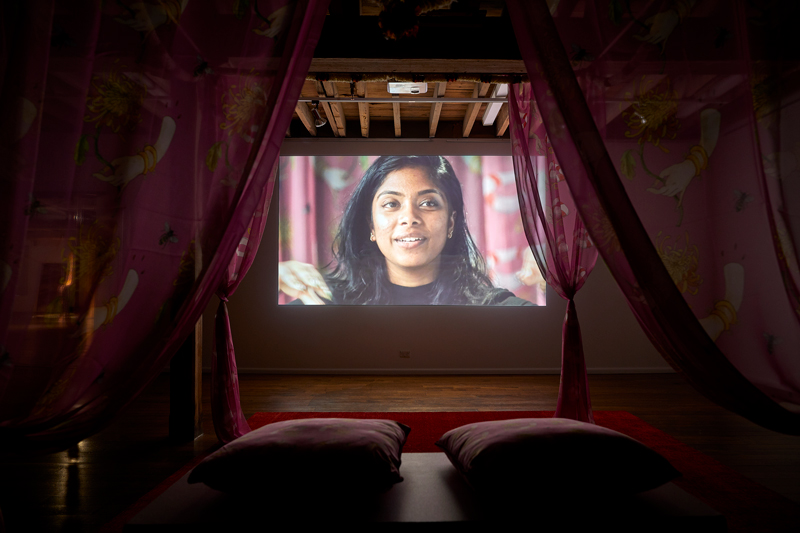
Begg’s Stories of Kannagi is a video installation work on which co-curator Jiva Parthipan was the creative producer. It is presented within a sumptuous evocation of a Sri Lankan exterior. The film reimagines the ancient 2,000-year-old Silapathikaram epic that tells the story of a woman forced into exile who confronts and overthrows the king of her adopted post-exile home, so it also becomes the story of a troubled marriage. Here, the key threads are loyalty, forced migration and female empowerment, located in the character of the heroine, Kannagi. The film shifts back and forth between Kannagi’s story and the statements by Tamil women writers – one, an ex-Tamil Tiger fighter.
Hoda Ashfar’s The Westoxicated is a striking and seductive series of five large-format photographic images from the series Under Western Eyes. They problematise the representation of Islamic women as veiled, subjugated and suppressed. They also destabilise (as parody) the often-pompous nature of formal portraiture though the inclusion of objects from Western pop and consumer culture. In reflection upon her birthright, Ashfar explains, “My ‘Iranian-ness’ was not something I considered much until I discovered that, in the mind of the new society, there existed an image of me that seemed to overshadow my entire personal history and being. I had to confront all those stereotypes that so many migrants from Islamic countries routinely experience.” These include being “secretly fashion-loving or sexually free: an object of fear and fascination … bound up with a cleverly disguised form of cultural imperialism.”
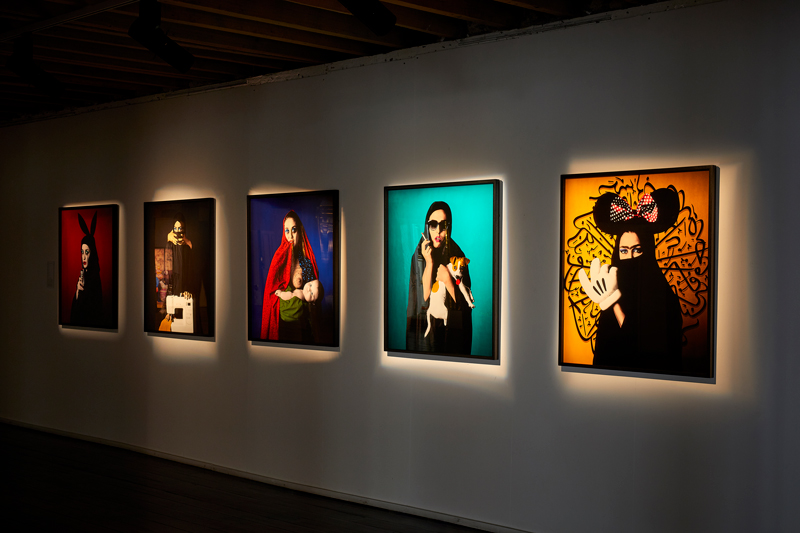
In contrast to the impressive scale of Ashfar’s work, Khaled Sabasi’s Tripoli is a composite work comprising eight intimate, painterly depictions of contemporary views of Tripoli. Tripoli is Sabsabi’s birthplace, which he describes as his place of separation and, possibly, a place of reunion. Pedro de Almeida’s observations on War in Guerilla (2016), are apposite in relation to Sabasi’s project, “War is ugly and yet, paradoxically, images do not necessarily make it so. From antiquity until now, scenes of war are embedded with an attractiveness that appeals to humanity’s darker, more atavistic appetite. To take brush and paint to these intimately-scaled facsimiles of the real, as the artist does, is to both acknowledge this and attempt to re-order its depressing logic.”[4]
Justine Youssef’s work, Under the table I learnt how to feed you, re-affirms the strength of a sense of culture and community as the artist documents the women in her family as they “arrogate space” in the courtyard of a Lebanese bakery in south-west Sydney. She states “These women’s actions speak to the invisibility of women in public spaces, positing matrilineal gestures as forms of resilience and resistance in the face of ongoing branding, urban development and gentrification of Western Sydney. Through methods of social engagement, I connect familial histories and local narratives of undocumented immigrant labour with present politics of gentrification and displacement.”[5]
Khadim Ali grew up in Pakistan as an Afghan refugee and was trained in classical miniature painting at the National College of Arts in Lahore. Like many students trained this way he applied the historical tradition of Mughal painting to controversial contemporary subject matter. Ali’s paintings tell stories about loss (of his own cultural heritage and of human values), and about how meaning shifts as words and images are perverted through ideological adoption. Untitled #19 (from the Arrivals series) depicts demons crowding the deck of a wooden boat, wearing yellow life jackets. It reflects the plight of refugees subject to dispossession and racial vilification. The demon (derived from Rostom the traditional Demon hero of heroes depicted as a horned demon), also refers to the way in which the character is used as a negative representation of Afghani Hazaras (like Ali) by Sunni Afghans. As Ali states, “Now we have demons on boats. They are asylum seekers. The demons are coming.”
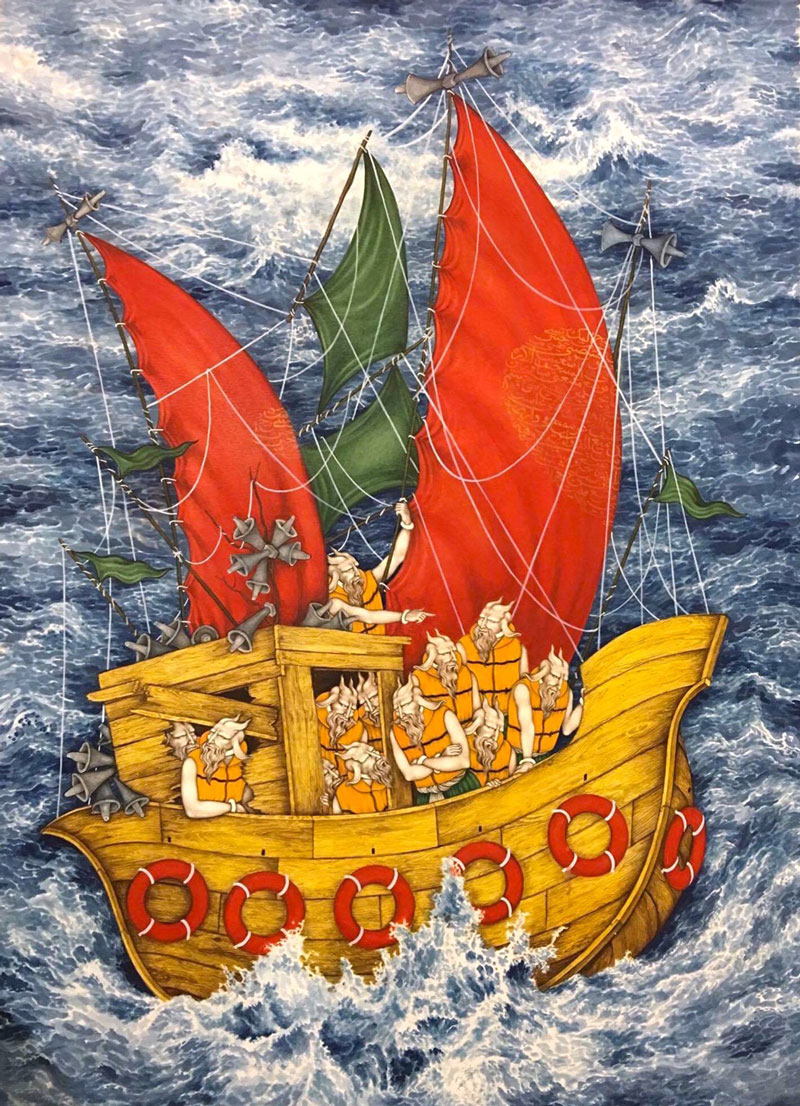
Slippage is the collaborative practice of Australian-born Chinese Vietnamese contemporary artists, Whafern Quach and Phuong Ngo. In this exhibition they present Drunken Swine (a triptych and installation), Madonna and Piglet and Severed (pigment prints only), referencing early twentieth-century ethnographic photography and the popularity of cognac within the global Vietnamese diaspora through ceramic liqueur bottles displayed atop elegant tables. This examination of vernacular cultures embedded within history highlights the impact of the French occupation on the Vietnamese diaspora as yet another example of an imposed hierarchy of values that continue to be culturally adapted.
The image set presents large-scale tableaux of sitters in the formal poses of historically imported European portrait photography. These sitters are placed in Indo-Chinese settings, clad in elegant oriental dress. But here, in a more liberal departure from the narrative they sport carnivalesque synthetic pig’s heads, their exposed white hands and feet signalling the adoption of European cultural attributes in a colonised world.
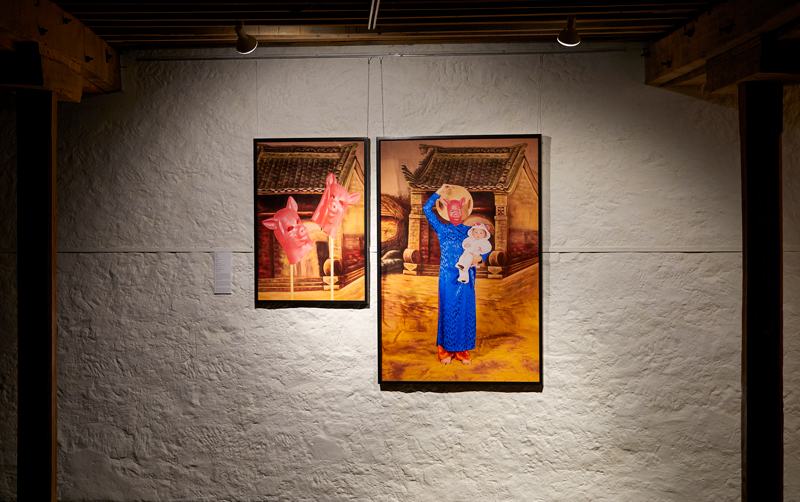
Amongst the culturally rich pools of insight into the migrant experience on display here are strong works from Tintin Wulia, Lemlem Atakilt and Elsa Gebhremedhin, Georgia Morgan and Shireen Taweel, as well as an installation in the adjacent Kelly’s Garden curated by local curator–artists Nadia Rafei and Ainsley Macaulay. Collectively, these works go some way to support the stated aim of curator Nina Miall of “remapping the social and cultural cartography of Australia to include more complex interrelations of alternative histories, subjectivities and trajectories, in the process destabilising the notion of any singular national identity.”
Footnotes
- ^ From an Interview with Nicholas Tsoutas in Nicholas Tsoutas (ed.), Discontinued Narratives: Elizabeth Day, Connie Dietzchold Gallery, Sydney, Cologne, Hong Kong, 2017.
- ^ Statement by Nina Miall and Jiva Parthinan, curators of Older Than Language, Salamanca Arts Centre, Hobart.
- ^ Peter Hutchings in foreword to Discontinued Narratives: Elizabeth Day.
- ^ Pedro de Almeida, “Khaled Sabsabi: Guerilla,” in The National: New Australian Art [exhibition catalogue], Art Gallery of New South Wales, Carriageworks, Museum of Contemporary Art Australia, 2017.
- ^ Published in Copyright Agency undated online Newsletter. (Author not credited).












